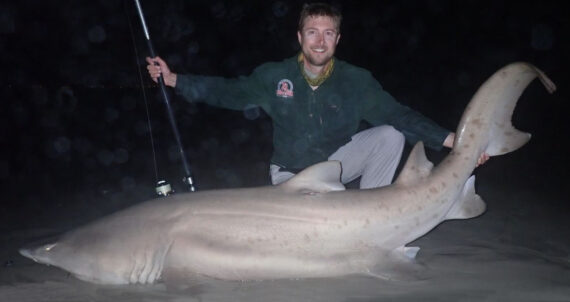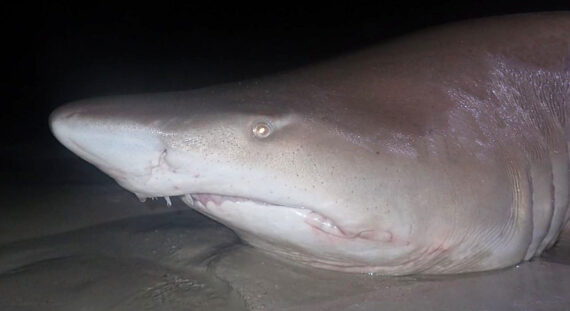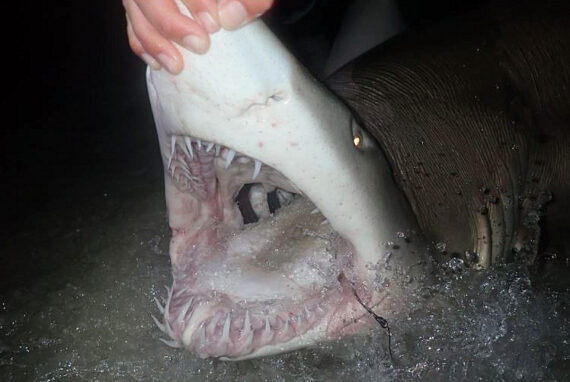Sand Tiger, Carcharias taurus


 Sand Tiger, Carcharias taurus. Fish caught from coastal waters off Struisbaai, South Africa, March 2019. Length: 2.3 m (7 feet 6 inches). Weight: 130 kg (286 lbs). Catch, photograph and identification courtesy of Ben Cantrell, San Diego, California.
Sand Tiger, Carcharias taurus. Fish caught from coastal waters off Struisbaai, South Africa, March 2019. Length: 2.3 m (7 feet 6 inches). Weight: 130 kg (286 lbs). Catch, photograph and identification courtesy of Ben Cantrell, San Diego, California.
 Sand Tiger, Carcharias taurus. Fish caught from coastal waters off Struisbaai, South Africa, March 2019. Length: 2.3 m (7 feet 6 inches). Weight: 130 kg (286 lbs). Catch, photograph, and identification courtesy of Josh Leisen (joshadventures.com), Gaylord, Michigan.
Sand Tiger, Carcharias taurus. Fish caught from coastal waters off Struisbaai, South Africa, March 2019. Length: 2.3 m (7 feet 6 inches). Weight: 130 kg (286 lbs). Catch, photograph, and identification courtesy of Josh Leisen (joshadventures.com), Gaylord, Michigan.
The Sand Tiger, Carcharias taurus, is a member of the Sand Shark or Odontaspididae Family, that is also known as the Dogfish Shark, the Gray Nurse Shark, the Ground Shark, the Spotted Ragged-tooth Shark, and the Sand Tiger Shark and in Mexico as tiburón arenero tigre. Globally, there is one current species in the genus Carcharias and is found in Mexican waters of the Atlantic. There are as many as nineteen extinct Carcharias.
The Sand Tiger is large and bulky in stature with a pointed head that has a long flattened conical snout. They are light brown or light greenish-gray dorsally, transitioning to white ventrally. Some fish have dark reddish or brown spots scattered on the body. Their caudal fin is asymmetric with a strongly pronounced upper lobe. Their anal and dorsal fins are of similar size and are broad based. Their first dorsal fin is found back on the body and is closer to the pelvic fins than to the pectoral fins. Their second dorsal fin is similar in size to the first. Their mouth is long and extends past the small eyes and is equipped with three rows of protruding, smooth-edged, sharp-pointed teeth with 44 to 48 upper teeth and 41 to 46 lower teeth. Their ragged looking teeth give the Sand Tiger a menacing appearance. They have large broad-based anal and dorsal fins. Their gill slits are behind the pectoral fins. The males have gray claspers with white tips located on the underside of the body. They are covered with dermal denticles.
The Sand Tiger Shark is found in subtropical and temperate waters worldwide in the Atlantic, Indian and Pacific Oceans from the sandy shorelines to the continental shelf and submerged reefs. They are absent from the Eastern Pacific. They are found in the coastal surf zone at depths of less than 25 m (82 feet) but range as deep as 190 m (625 feet) and normally near the bottom in or near deep sandy-bottomed gutters or rocky caves, usually in the vicinity of inshore rocky reefs and islands. The sexes are dimorphic and females are larger than males, reaching a maximum length of 3.20 m (10 feet 8 inches) and 159 kg (351 lbs) in weight, versus 3.00 m (9 feet 9 inches) for the males. As of January 1, 2024, the International Game Fish Association world record stood at 159 kg (351 lbs) with the fish caught in coastal waters off Charleston, South Carolina in April 1993. Sand Tiger Sharks are active nocturnally and will hunt as solitary individuals or in small groups of up to twenty individuals. They are slow moving and most active during night time hours and during the day, they take shelter near rocks, overhangs, caves and reefs, often at relatively shallow depths. They are known to make long annual migrations, moving to cooler waters during the summers, where they reproduce, and to warmer waters in the winter preferring water temperatures between 12.5oC (54oF) and 28oC (82oF). They are unique among the sharks, being denser than water and lacking a swim-bladder. They will come to the surface to gulp air which is held in the stomach and affords them neutral buoyancy, allowing them to hover motionless in the water. They consume a wide range of prey, including bony fish, rays, crabs, lobsters, and other small sharks. In turn, the juvenile Sand Sharks are preyed upon by other sharks; the adults are only preyed upon by humans which has caused significant decreases in global populations. They are believed to be beneficial by regulating prey populations. They have a parasitic relationship with Lampreys. They have a mutual relationship with Pilotfish, Naucrates doctor, which provide cleaning services in exchange for food. Males outnumber females by 2 to 1. Reproduction is ovoviviparous and involves internal fertilization with eggs developing inside the female in each uterus. Each female is polygynandrous and will mate with more than one male. Gestation periods are from eight to twelve months. Each female has two uterine horns and will produce as many as 50 embryos but then they reach 10 cm (4 inches) in length one of the larger embryos in each horn starts eating the smaller embryos (adelphophagy or intrauterine cannibalism) until only it remains. Each female will give birth to one or two 1.0 m (3 feet 3 inches) to 1.5 m (4 feet 10 inches) miniature adult pups that are totally independent. Each female will give birth only every second or third year and average less than one pup per year, one of the lowest reproductive rates of all sharks. Their life spans are estimated to be thirty-five years.
The Sand Tiger can be easily confused with the Bigeye Sand Shark, Odontaspis noronhai (caudal fin with very small lower lobe; big eyes; no spots on body) and the Ragged-tooth Sand Shark, Odontaspis ferox (caudal fin with equal sized lobes; no spots on the body).
The Sand Tiger is a resident of the Atlantic, Indian and Pacific Oceans. In Mexican waters they have a limited range, being found off the East Coast of the Yucatán in the Caribbean on a seasonal basis.
From a conservation perspective the Sand Tiger is currently considered to be CRITICALLY ENDANGERED. Population declines worldwide have been estimated at 20% over the last ten years with major factors including their unusual low reproductive rates, commercial fishing for their hide, fins, liver oil, and meat, recreational fishing, use by the aquarium trade and coastal habitat destruction.
The Sand Tiger has a large size and sharp protruding teeth however they are not considered to be threats to humans, with no known documented global attacks. They can be found in many of the larger public aquariums around the world. They are popular because of their large stature, menacing appearance, docile nature and relatively easy maintenance. They are also targeted by scuba divers as they can be readily approached and are not aggressive unless provoked. In some cultures, they are considered to be an exceptional food fish being pursued by both commercial and recreational fishermen, being caught by hook-and-line, spear-fishermen and by gill-nets and trawlers. In some parts of the world they are heavily regulated. They are also utilized in fish meal, fish oils, the shark fin trade, for their leather and for their teeth and jaws via the curio trade. Many fish are killed by beach mesh netting utilized to protect swimmers from shark attacks. Sand Tigers have a fierce appearance and have an undeserved reputation as man eaters.